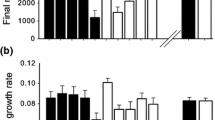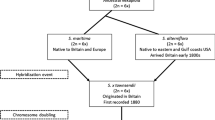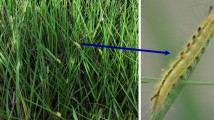Abstract
Invasive plants are often larger in their introduced range compared to their native range. This may reflect an evolved reduction in defense and increase in growth in response to low herbivory in their introduced range. Key elements of this scenario include genetic differences in defense and growth yet uniformly low rates of herbivory in the field that dissociate defense and herbivore damage for alien species. We conducted a laboratory experiment with Melanoplus angustipennis grasshoppers and Chinese Tallow Tree seedlings (Sapium sebiferum) from its native range (China) and its introduced range (Texas, USA) where it is invasive. We caged grasshoppers with pairs of Sapium seedlings from the same continent or different continents. The amounts of leaf area removed from Texas and China seedlings, and their height growth rates, were indistinguishable when both seedlings in the pair were from the same continent. However, when grasshoppers had a choice between seedlings from different continents, they removed more Texas Sapium foliage than China Sapium foliage and height growth rates were higher for China Sapium seedlings compared to Texas seedlings. Grasshopper growth rates increased with greater Sapium foliage consumption. In a common garden in Texas, Sapium seedlings from Texas grew 40% faster than those from China. Chewing insect herbivores removed little Sapium foliage in the field experiment. Although grasshoppers preferred to feed on Texas Sapium when offered a choice in the laboratory, extremely low herbivory levels in the field may have allowed the Texas seedlings to outperform the China seedlings in the common garden. These results demonstrate post-invasion genetic differences in herbivore resistance and growth of an invasive plant species together with a decoupling of defense and herbivore choice in the introduced range.



Similar content being viewed by others
References
Alexander G, Hilliard JR (1969) Altitudinal and seasonal distribution of Orthoptera in the Rocky Mountains of northern Colorado. Ecol Monogr 39:385–431
Alpert P, Bone E, Holzapfel C (2000) Invasiveness, invasibility and the role of environmental stress in the spread of non-native plants. Perspect Plant Ecol Evol Syst 3:52–66
Bazzaz FA, Chiariello NR, Coley PD, Pitelka LF (1987) Allocating resources to reproduction and defense. BioScience 37:58–67
Beccaloni GW, Symons FB (2000) Variation of butterfly diet breadth in relation to host-plant predictability: results from two faunas. Oikos 90:50–66
Blossey B, Nötzold R (1995) Evolution of increased competitive ability in invasive nonindigenous plants: a hypothesis. J Ecol 83:887–889
Bruce KA, Cameron GN, Harcombe PA, Jubinsky G (1997) Introduction, impact on native habitats, and management of a woody invader, the Chinese Tallow Tree, Sapium sebiferum (L.) Roxb. Nat Areas J 17:255–260
Camara MD (1997) A recent host range expansion in Junonia coenia Hubner (Nymphalidae): oviposition preference, survival, growth, and chemical defense. Evolution 51:873–884
Capinera JL (1993) Host-plant selection by Schistocerca americana (Orthoptera, Acrididae). Environ Entomol 22:127–133
Chew FS, Courtney SP (1991) Plant apparency and evolutionary escape from insect herbivory. Am Nat 138:729–750
Coley PD, Bryant JP, Chapin FS (1985) Resource availability and plant antiherbivore defense. Science 230:895–899
Crawley MJ (1987) What makes a community invasible? In: Gray AJ, Crawley MJ, Edwards PJ (eds) Colonization, succession and stability. Blackwell, Oxford, pp 429–453
Daehler CC, Strong DR (1997) Reduced herbivore resistance in introduced smooth cordgrass (Spartina alterniflora) after a century of herbivore-free growth. Oecologia 110:99–108
Ehmke A, Proksch P, Witt L, Hartmann T, Isman MB (1989) Fate of ingested pyrrolizidine alkaloid-oxide in the grasshopper Melanoplus sanguinipes. Naturwissenschaften 76:27–29
Elton CS (1958) The ecology of invasion by plants and animals. Chapman and Hall, London
Fox CW, Savalli UM (2000) Maternal effects mediate host expansion in a seed-feeding beetle. Ecology 81:3–7
Fox CW, Nilsson JA, Mousseau TA (1997) The ecology of diet expansion in a seed-feeding beetle: pre-existing variation, rapid adaptation and maternal effects? Evol Ecol 11:183–194
Hsu FL, Lee YY, Cheng JT (1994) Antihypertensive activity of 6-O-galloyl-D-glucose a phenolic glycoside from Sapium sebiferum. J Nat Prod Lloydia 57:308–312
Huntly N, Inouye R (1988) Pocket gophers in ecosystems: patterns and mechanisms. Bioscience 38:786–793
Joern A (1982) Distributions, densities, and relative abundances of grasshoppers (Orthoptera: Acrididae) in a Nebraska sandhills prairie. Prairie Nat 14:37–45
Keane RM, Crawley MJ (2002) Exotic plant invasions and the enemy release hypothesis. Trends Ecol Evol 17:164–170
Lodge DM (1993) Biological invasions: lessons for ecology. Trends Ecol Evol 8:133–137
Mack RN, Simberloff D, Lonsdale WM, Evans H, Clout M, Bazzaz FA (2000) Biotic invasions: causes, epidemiology, global consequences, and control. Ecol Appl 10:689–710
Majak W, Johnson DL, Benn MH (1998) Detoxification of 3-nitropropionic acid and karaka by melanopline grasshoppers. Phytochemistry 49:419–422
Maron JL, Vila M (2001) When do herbivores affect plant invasion? Evidence for the natural enemies and biotic resistance hypotheses. Oikos 95:361–373
Maschinski J, Whitham T (1989) The continuum of plant responses to herbivory: the influence of plant association, nutrient availability and timing. Am Nat 134:1–19
Nijjer S, Lankau RA, Rogers WE, Siemann E (2002) Effects of temperature and light on Chinese Tallow (Sapium sebiferum) and Texas Sugarberry (Celtis laevigata) seed germination. Tex J Sci 54:1–6
Ohigashi H, Ohtsuka T, Hirota M, Koshimizu K, Tokuda H, Ito Y (1983) Tigliane type diterpene-esters with Epstein-Barr virus-inducing activity from Sapium sebiferum. Agric Biol Chem 47:1617–1622
O'Reilly-Wapstra JM, McArthur C, Potts BM (2002) Genetic variation in resistance of Eucalyptus globulus to marsupial browsers. Oecologia 130:289–296
Pavia H, Toth GB, Aberg P (2002) Optimal defense theory: elasticity analysis as a tool to predict intraplant variation in defenses. Ecology 83:891–897
Pradhan B, Nath A, Shoolery J (1984) Triterpenoid acids from Sapium sebiferum. Phytochemistry 23:2593–2595
Ritchie ME, Tilman D (1992) Interspecific competition among grasshoppers and their effect on plant abundance in experimental field environments. Oecologia 89:524–532
Rogers WE, Siemann E (2003) Effects of simulated herbivory and resources on Chinese tallow tree (Sapium sebiferum, Euphorbiaceae) invasion of native coastal prairie. Am J Bot 90:241—247
Schmitz OJ (1994) Resource edibility and trophic exploitation in an old-field food web. Proc Natl Acad Sci USA 91:5364–5367
Shea K, Chesson P (2002) Community ecology theory as a framework for biological invasions. Trends Ecol Evol 17:170–176
Siemann E, Rogers WE (2001) Genetic differences in growth of an invasive tree species. Ecol Lett 4:514–518
Siemann E, Rogers WE (2003) Herbivory, disease, recruitment limitation and success of alien and native tree species. Ecology 84 (in press)
Simms EL, Rausher M (1987) Costs and benefits of plant resistance to herbivory. Am Nat 130:570–581
Solarz SL, Newman RM (2001) Variation in hostplant preference and performance by the milfoil weevil, Eurychiopsis lecontei Dietz, exposed to native and exotic milfoils. Oecologia 126:66–75
Strong DR (1974) Rapid asymptotic species accumulation in phytophagous insect communities: the pests of cacao. Science 185:1064–1066
Strong DR, McCoy ED, Rey JR (1977) Time and the number of herbivore species: the pests of sugarcane. Ecology 58:167–175
Thebaud C, Simberloff D (2001) Are plants really larger in their introduced ranges? Am Nat 157:231–236
Tilman D (1999) The ecological consequences of changes in biodiversity: a search for general principles. Ecology 80:1455–1474
Traxler MA, Joern A (1999) Performance tradeoffs for two hosts within and between populations of the oligophagous grasshopper Hesperotettix viridis (Acrididae). Oikos 87:239–250
Ueckert DN, Hansen RM (1971) Dietary overlap of grasshoppers on sandhill rangeland in northeastern Colorado. Oecologia 8:276–295
Willis AJ, Blossey B (1999) Benign environments do not explain the increased vigour of non-indigenous plants: a cross-continental transplant experiment. Biocontrol Sci Technol 9:567–577
Willis AJ, Memmott J, Forrester RI (2000) Is there evidence for the post-invasion evolution of increased size among invasive plant species. Ecol Lett 3:275–283
Yang P, Kinghorn AD (1985) Coumarin constituents of the Chinese Tallow Tree (Sapium sebiferum). J Nat Prod Lloydia 48:486–488
Yela JL, Lawton JH (1997) Insect herbivore loads on native and introduced plants; a preliminary study. Entomol Exp Appl 85:275–279
Acknowledgements
We would like to thank: Yao Huang, Mr. Li, Xang Yanci, and Jie Lin for assistance in obtaining seeds from China; Jacob Ferris, Maria Hartley, Rick Lankau, and Summer Nijjer for assistance; O.J. Schmitz for cage design protocol; the University of Houston Coastal Center for permission to use their property and collect grasshoppers; and the National Science Foundation (DEB-9981654) for financial support.
Author information
Authors and Affiliations
Corresponding author
Rights and permissions
About this article
Cite this article
Siemann, E., Rogers, W.E. Reduced resistance of invasive varieties of the alien tree Sapium sebiferum to a generalist herbivore. Oecologia 135, 451–457 (2003). https://doi.org/10.1007/s00442-003-1217-4
Received:
Accepted:
Published:
Issue Date:
DOI: https://doi.org/10.1007/s00442-003-1217-4




